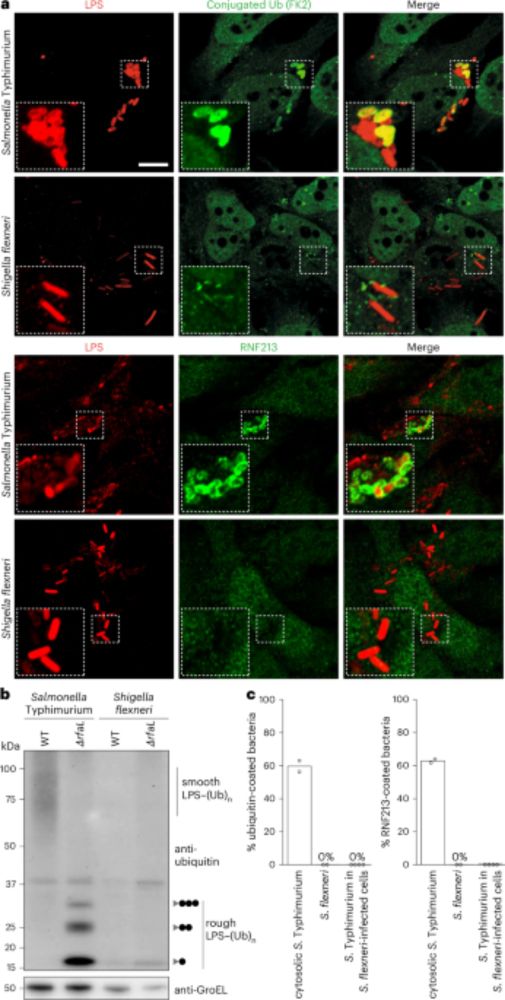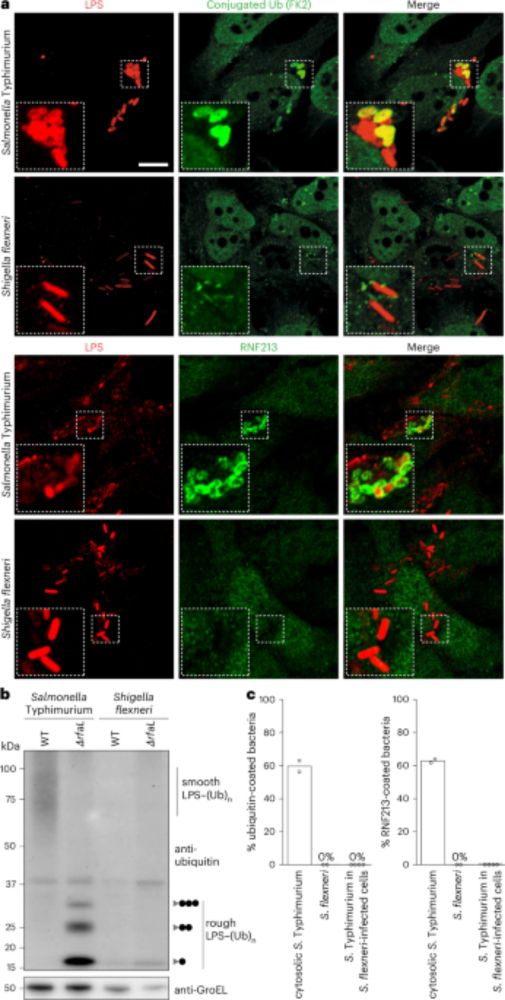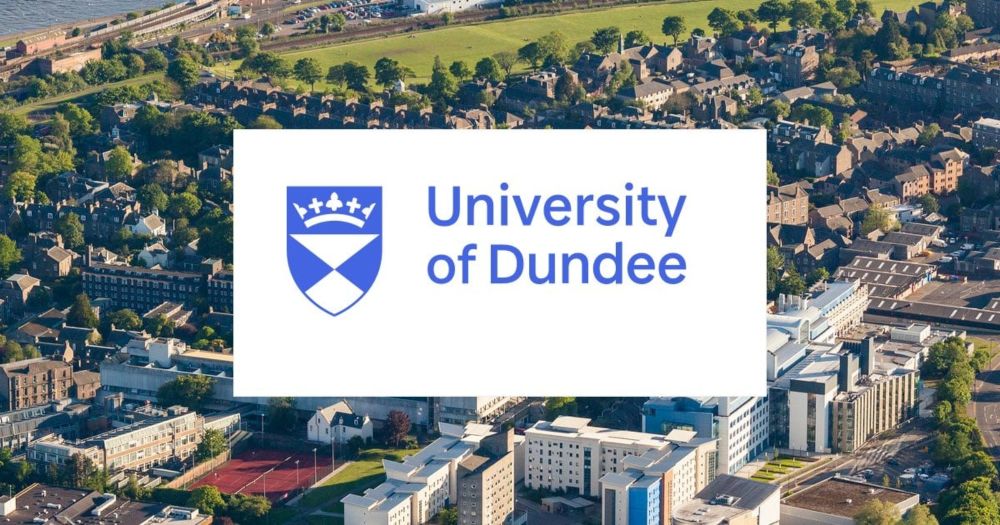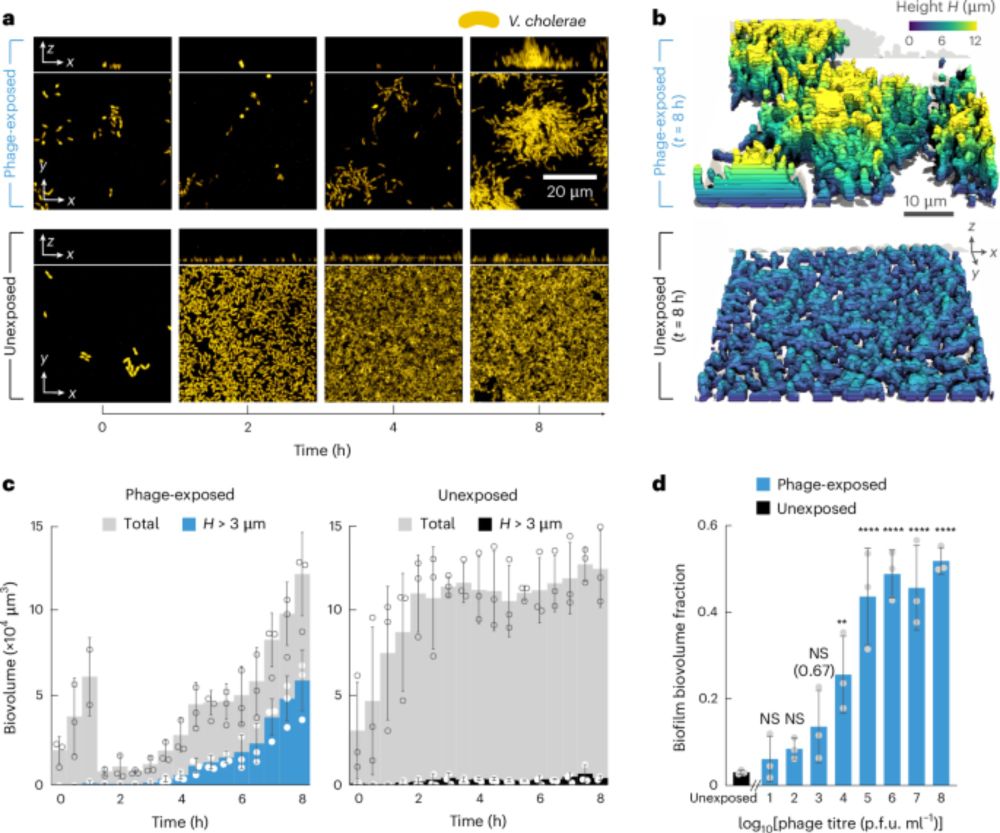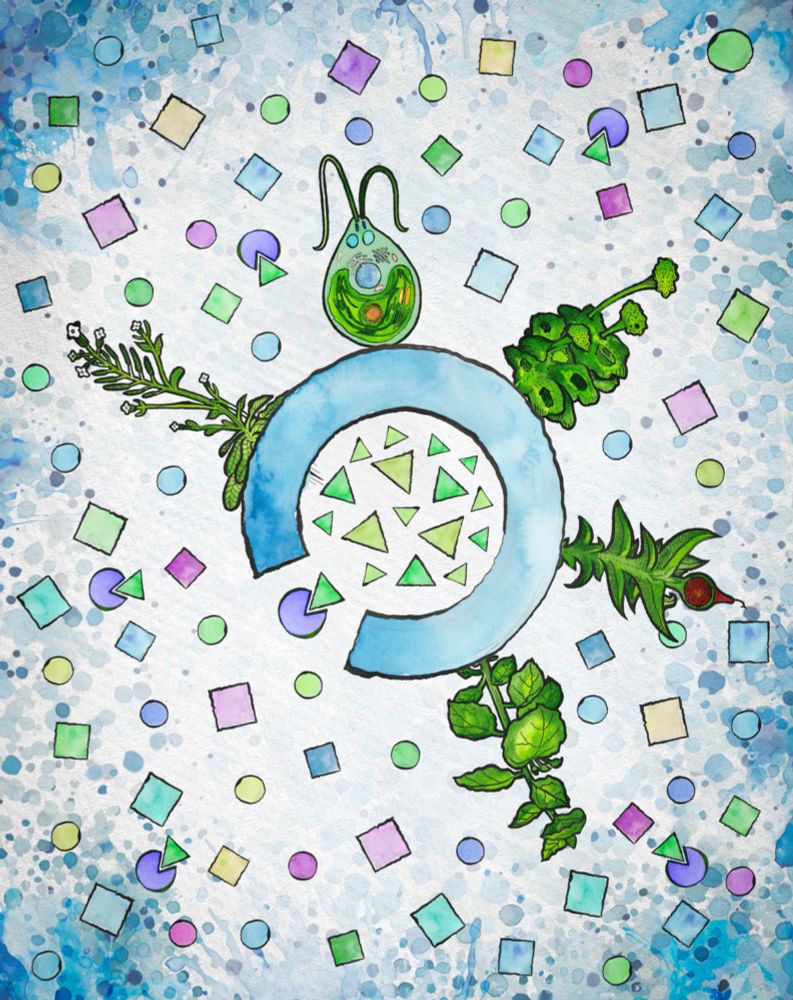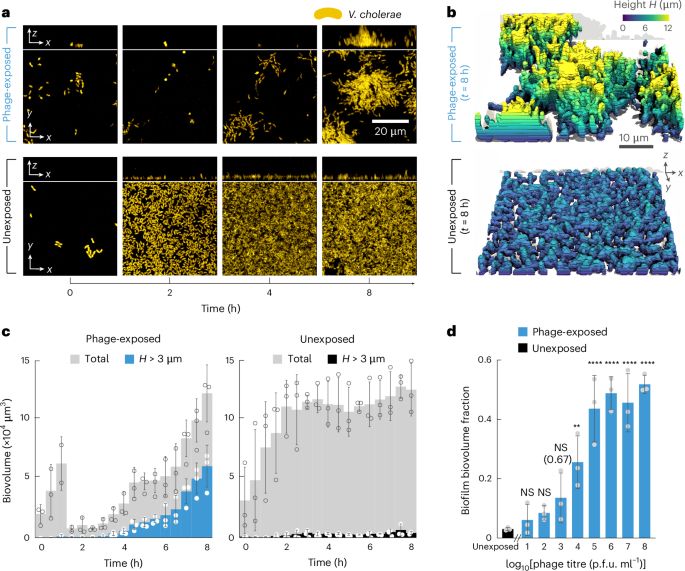
Mike Davey and Gisela Otten join Board of Directors | Cambridge United F.C.
Gisela Otten has joined the Board of Directors and will Chair the Board of the Women’s team at Cambridge United Football Club. Gisela joined @felixrandow.bsky.social's group at the LMB in 2017 and spent 6 years playing for Cambridge United Women. #LMBAlumni
www.cambridgeunited.com/news/mike-da...
14.07.2025 14:09 — 👍 9 🔁 1 💬 0 📌 0
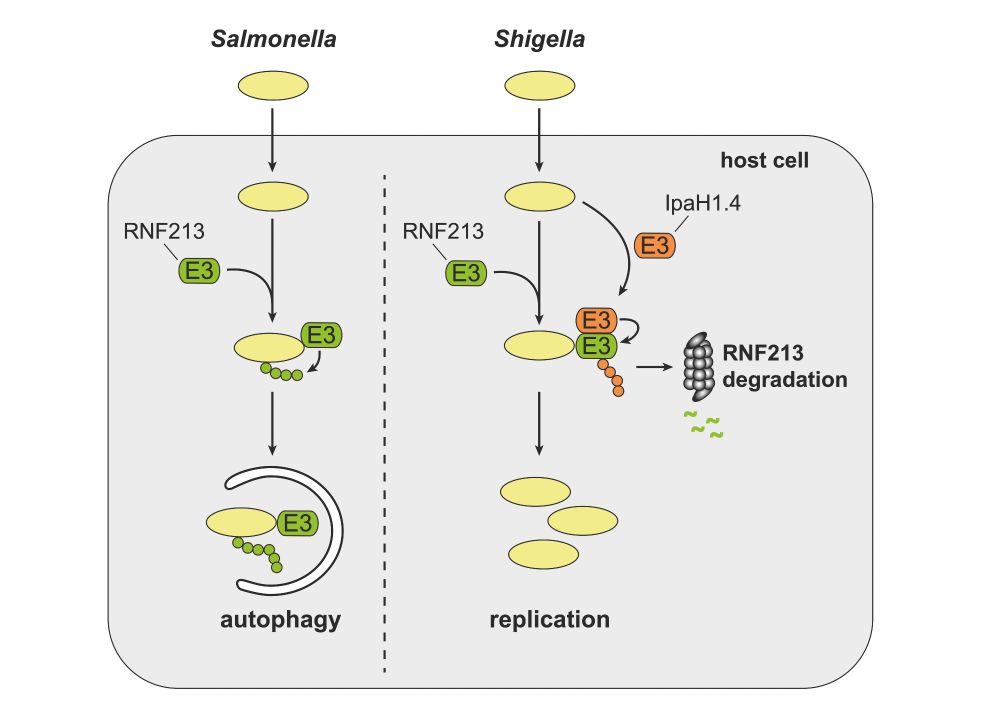
Comparison of Salmonella and Shigella host cell invasion. Salmonella are targeted by the host E3 ligase RNF213, which ubiquitylates bacterial lipopolysaccharide (LPS), marking bacteria for autophagic destruction. Shigella employs its effector proteins IpaH1.4 - an E3 ubiquitin ligase itself - to ubiquitylate RNF213, leading to its proteasomal degradation and thus preventing the host from tagging Shigella for destruction.
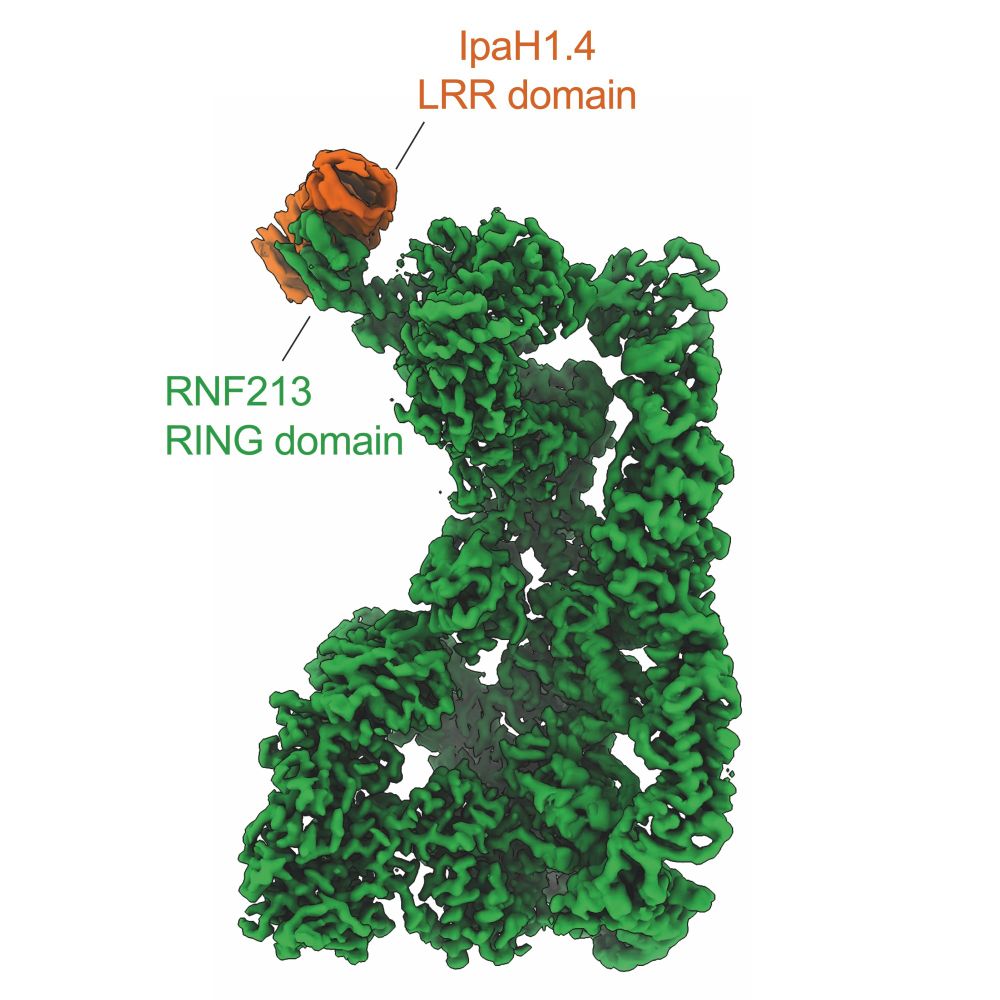
Cryo-EM structure showing how the leucine-rich repeat (LRR) domain of IpaH1.4 binds to the RING domain of RNF213
How do cytosol-invading bacteria evade LPS ubiquitylation by the host's defence machinery?
@felixrandow.bsky.social's group determined that Shigella flexneri uses IpaH1.4 to degrade the LPS ligase RNF213, inhibiting the cell's ubiquitylation abilities.
Read more: tinyurl.com/3y4kv2bp
#LMBResearch🧪
09.04.2025 09:09 — 👍 46 🔁 15 💬 1 📌 0
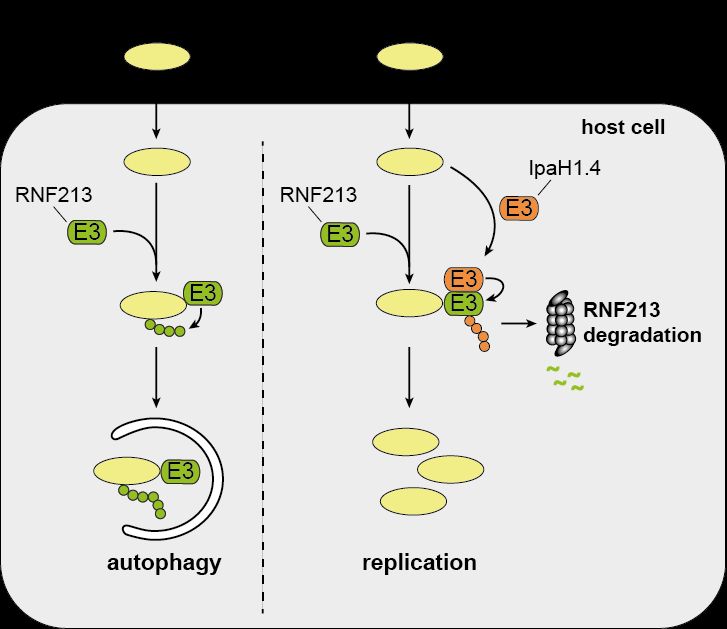
Don't miss similar findings from the Coers and Pan labs in BiorXiv and NatComm. Also note that Burkholderia antagonizes LPS ubiquitylation through DUB action (Thurston lab) and that Chlamydia deploys GarD (Coers lab). Conclusion: Bacteria decided RNF213 is a hot target in host–pathogen warfare!
09.04.2025 21:44 — 👍 6 🔁 0 💬 0 📌 0
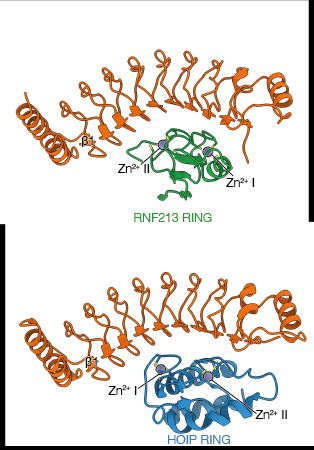
Remarkably, IpaH1.4 doesn’t stop at RNF213—it targets several host E3 ligases via their RING domains. Individual RINGs bind overlapping sites on IpaH1.4 through unique interactions, explaining specificity of IpaH1.4 towards select RING domains. A clever strategy!
09.04.2025 21:44 — 👍 5 🔁 0 💬 2 📌 0
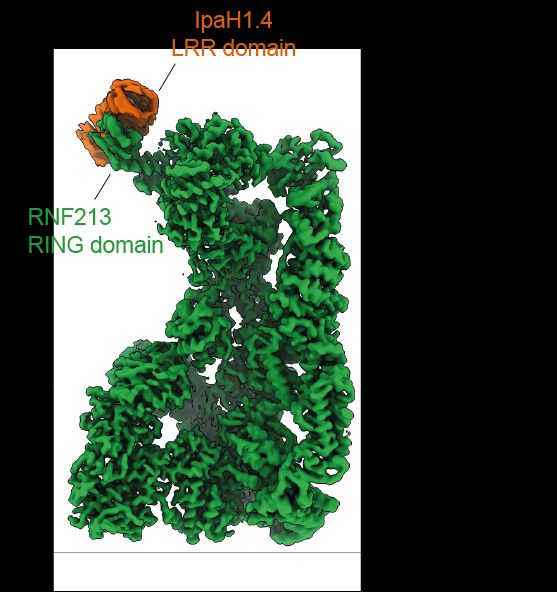
Cryo-EM reveals IpaH1.4 binds the RING domain of RNF213—a region with no known E3 activity in RNF213. However, despite pressure from IpaH1.4, the RING is highly conserved, hinting at a key function. Intriguingly, Moyamoya disease–linked mutations also occur in this domain.
09.04.2025 21:44 — 👍 3 🔁 0 💬 1 📌 0
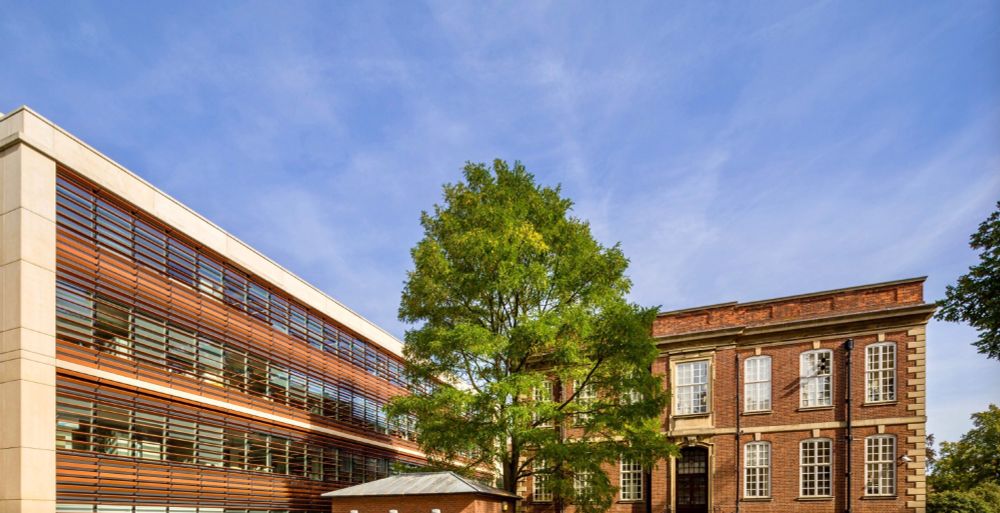
Not long until the deadline for this faculty position @dunnschool.bsky.social...
Are you the one to lead a group doing great research in a special environment, while teaching outstanding students?
www.path.ox.ac.uk/vacancy/asso...
17.02.2025 17:05 — 👍 18 🔁 18 💬 0 📌 0
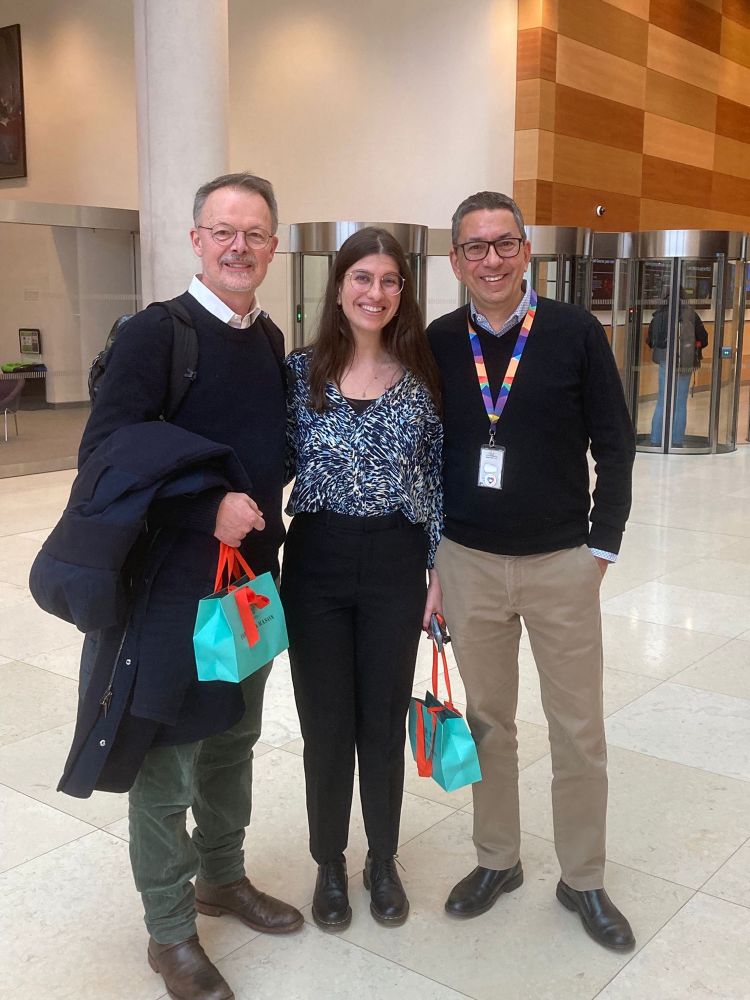
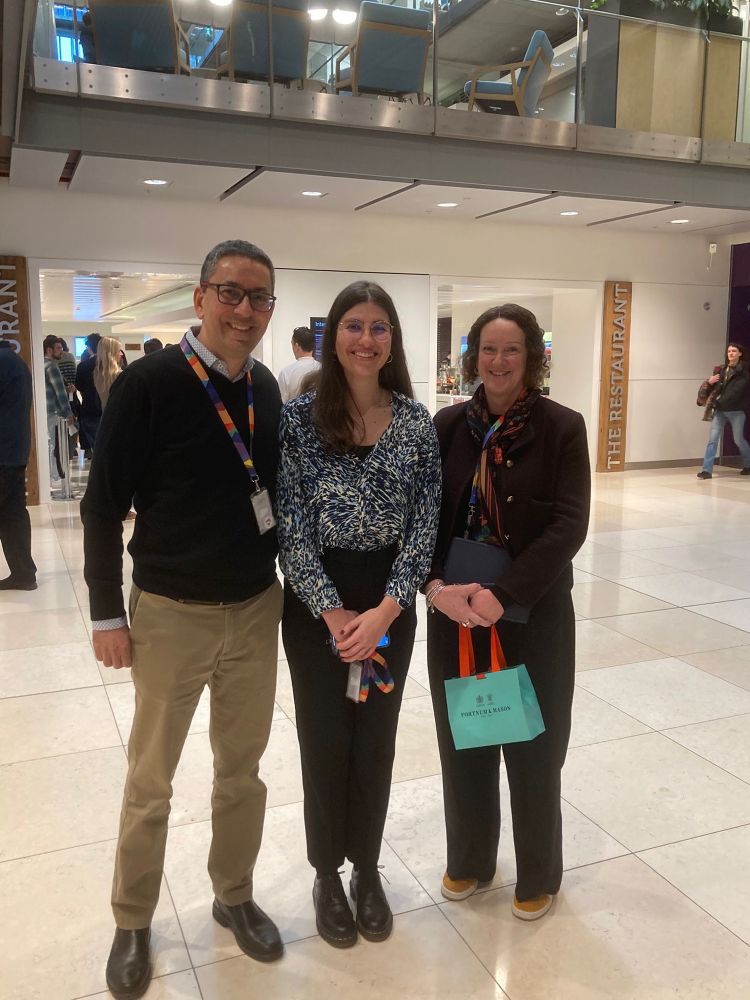
There are few moments more rewarding in running a lab than having a student defend their PhD thesis. Congratulations Dr. @marianapdc.bsky.social for this amazing achievement. And thanks to @lloydlab.bsky.social and Bart Lambrecht for being the examiners.
07.02.2025 20:45 — 👍 27 🔁 5 💬 2 📌 2

Lara Krüger, stood in the LMB atrium, smiling.
Congratulations to @lara-kruger.bsky.social, postdoc in @deriverylab.bsky.social in @cellbiol-mrclmb.bsky.social, who is leaving the LMB to establish her own research group at @institutcurie.bsky.social in Paris!
Best of luck to you Lara!
#LMBAlumni
06.02.2025 10:23 — 👍 30 🔁 5 💬 0 📌 3
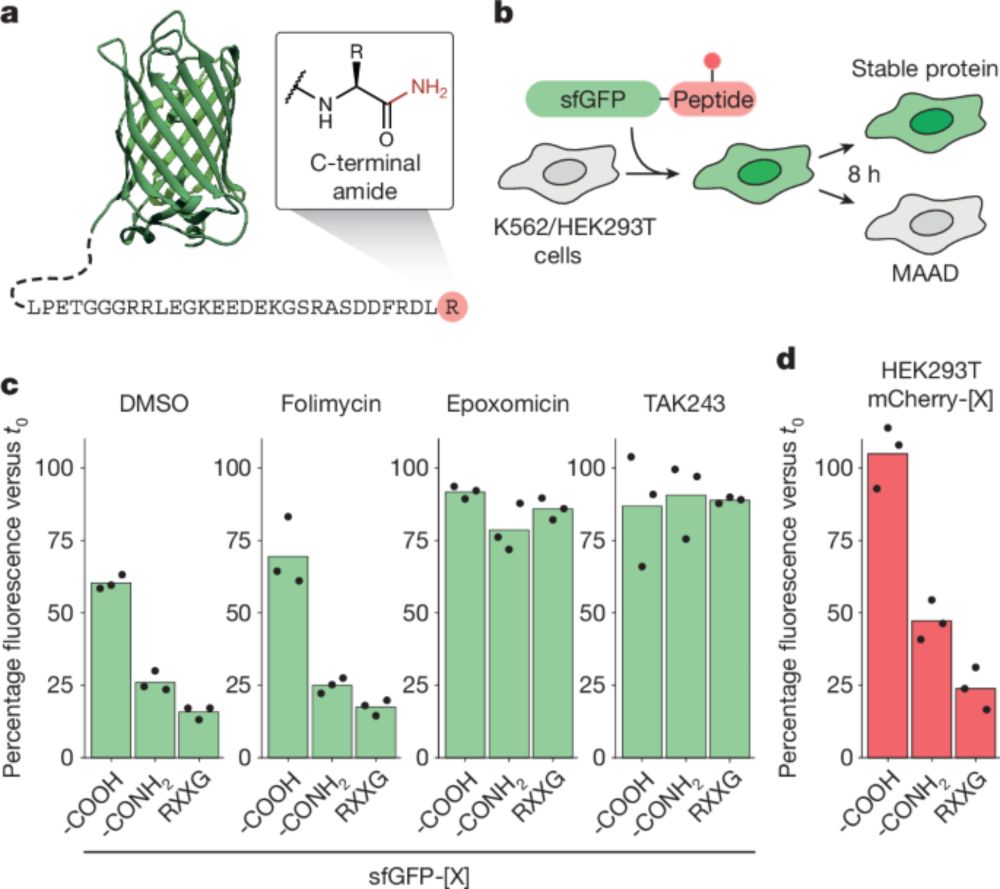
C-terminal amides mark proteins for degradation via SCF–FBXO31 - Nature
SCF–FBXO31 scans proteins for C-terminal amidation and marks them for subsequent proteasomal degradation.
How do cells recognise disease- and stress-affected proteins for clearance by ubiquitination? Work @nature shows that such proteins are marked with C-terminal amides, allowing their targeting by SCF/FBXO31 ubiquitin ligase for degradation. shorturl.at/B3rmR
& NV
shorturl.at/fImjA
29.01.2025 17:33 — 👍 12 🔁 4 💬 0 📌 0
Guess what? You got it, another @plosbiology.org focus issue of thought-provoking Perspectives and Essays on an issue relevant to this Keystone Symposium
What can I say? We clearly care a lot about many of the topics at these joint meetings
Take a look and let us know what you think! 👀⬇️
🧪
23.01.2025 00:49 — 👍 11 🔁 9 💬 0 📌 0
We made it to 100! 📢💯 The #ubiquitin and #ubl Starter Pack now includes 100 profiles to follow if you’re interested in any aspect of the field: signalling, structure and biochemistry, biology, mechanisms, proteostasis, TPD, chemical biology… Check out the list and let me know if you are missing.
21.01.2025 11:10 — 👍 32 🔁 13 💬 1 📌 1
Who’ll get the second popcorn??
17.01.2025 13:08 — 👍 1 🔁 0 💬 1 📌 0
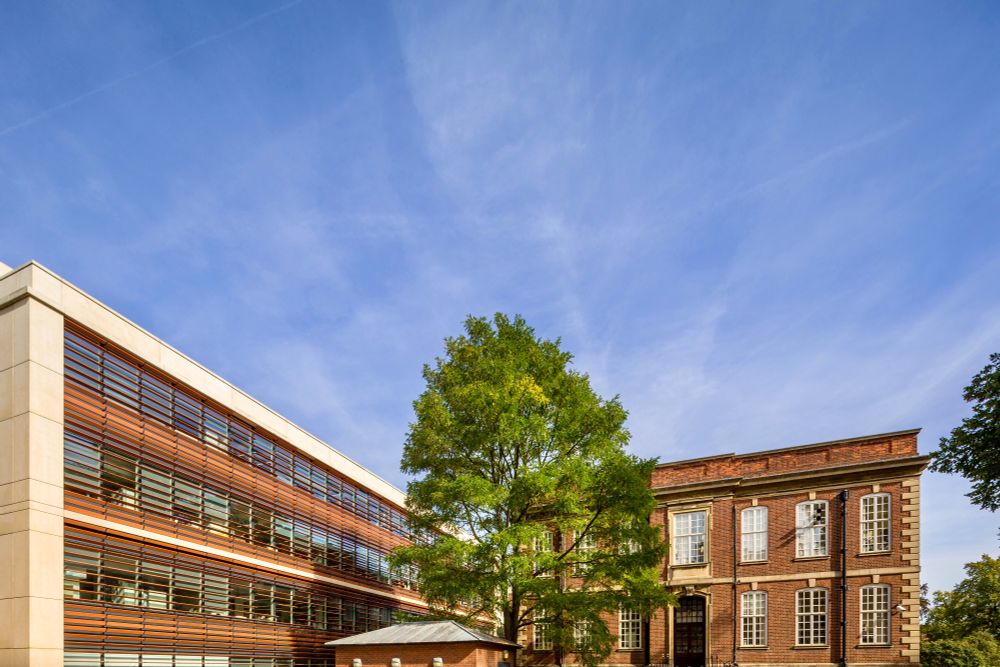
We just can't stop recruiting!
Associate professor in cell and molecular biology @dunnschool, with a preference for immunology, inflammation and/or infection - all defined broadly
Come and be our colleague
Deadline 28 Feb, please spread the word
www.path.ox.ac.uk/vacancy/asso...
14.01.2025 16:52 — 👍 48 🔁 59 💬 0 📌 1

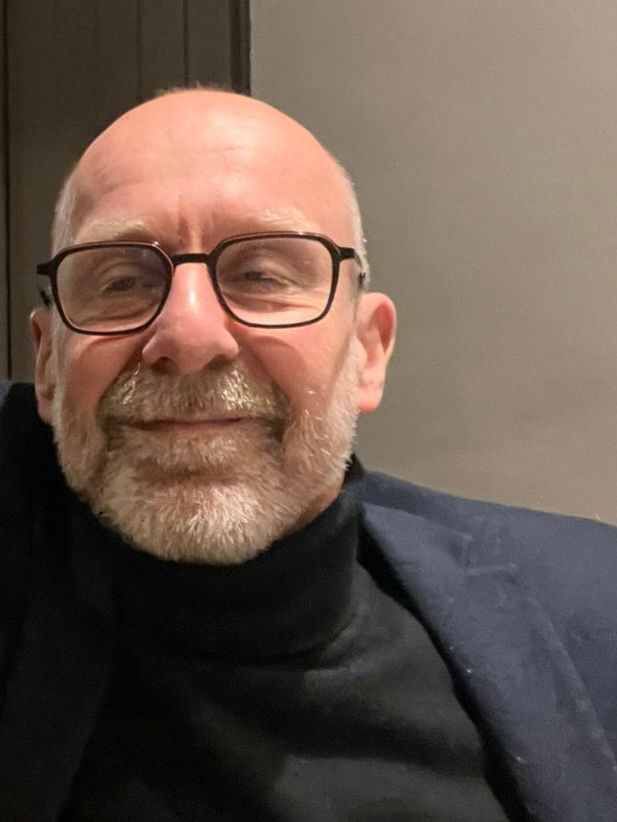
After lots of teasing by @npariente.bsky.social I updated my profile picture. No more impersonation of my younger self!
12.01.2025 12:36 — 👍 6 🔁 0 💬 0 📌 0
PhDs in biochemistry, structural biology, pharmacology, or similar, located in the US and with strong publication track records and a high motivation to solve Parkinson's, please send CV directly to me at jimhurley@berkeley.edu.
Repost appreciated.
09.01.2025 02:58 — 👍 70 🔁 56 💬 0 📌 1
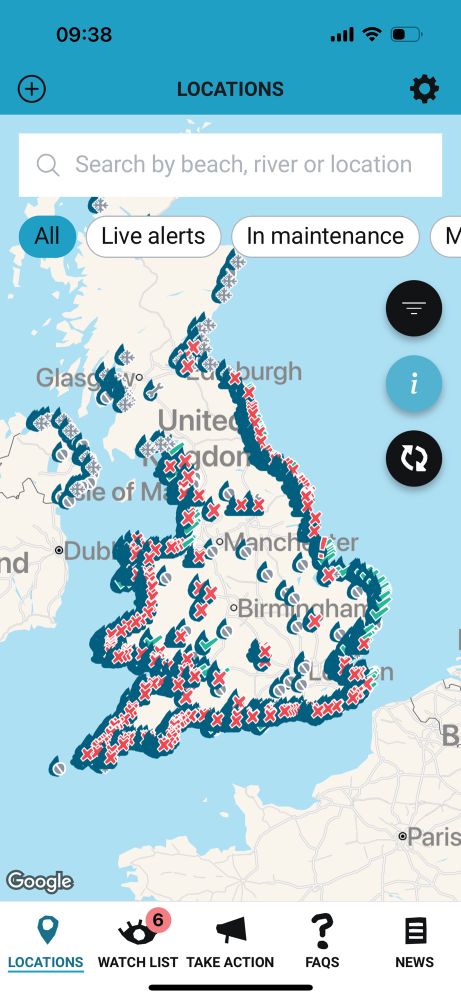
Real-time map from Surfers Against Sewage app. For those in blissful ignorance, this is what happens after normal heavy rains in Britain: huge swathes of UK coastline rendered unswimmable by water companies’ discharges. I know it’s old news but I refuse to become desensitized to the sheer awfulness
07.01.2025 09:50 — 👍 13 🔁 7 💬 1 📌 0
On Jan 6 1912, Alfred Wegener presented his theory of continental drift and supercontinent Pangaea's breakup into today's continents. Despite initial rejection, modern seismology and ocean drilling in the 1950s/60s validated his ideas, leading to the current understanding of plate tectonics. ⚒🧪
06.01.2025 09:19 — 👍 758 🔁 100 💬 23 📌 8
Happy New Year! Let’s start with an updated starter pack. Now with 94 profiles to follow if you are interested in anything #ubiquitin or #Ubl: signalling, structure and biochemistry, biology, mechanisms, proteostasis, TPD, chemical biology, etc. Let me know if you or anyone else is missing.
06.01.2025 13:02 — 👍 13 🔁 7 💬 3 📌 0
The pleasure was mine!
01.01.2025 21:21 — 👍 1 🔁 0 💬 0 📌 0
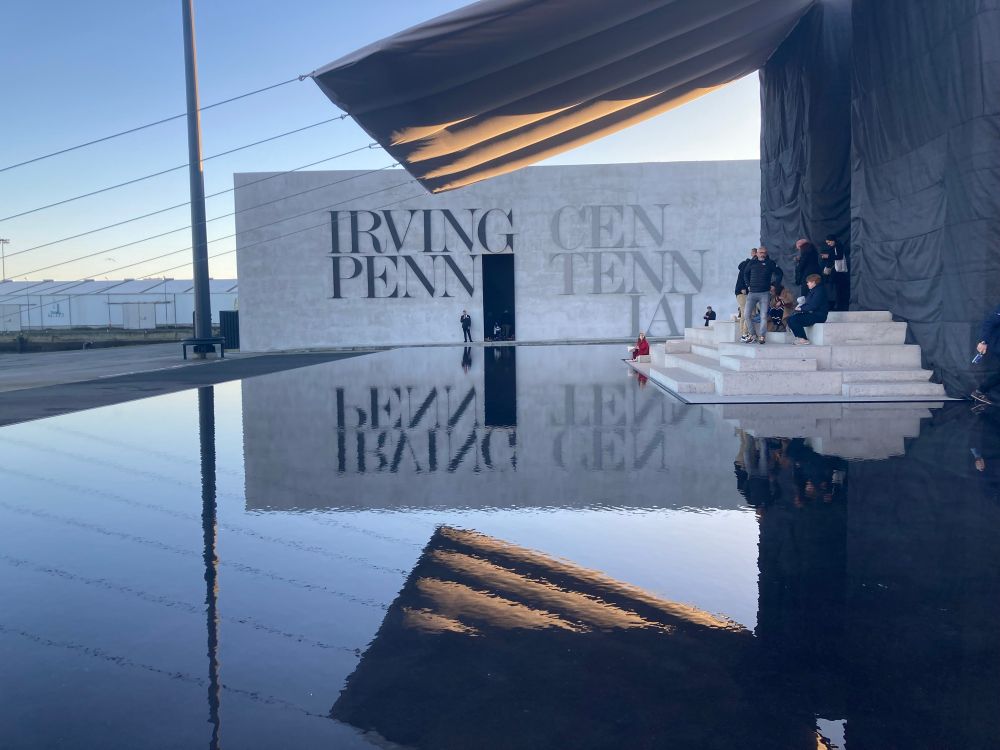
Today in A Coruña. It has become a nice tradition for us to visit their annual photo exhibition.
26.12.2024 18:20 — 👍 4 🔁 0 💬 2 📌 0
Believe it or not, GRC has told me we need more registered applicants or this meeting might not survive! Please don't let that happen if you can afford to attend 🙏
19.11.2024 22:46 — 👍 25 🔁 29 💬 2 📌 2
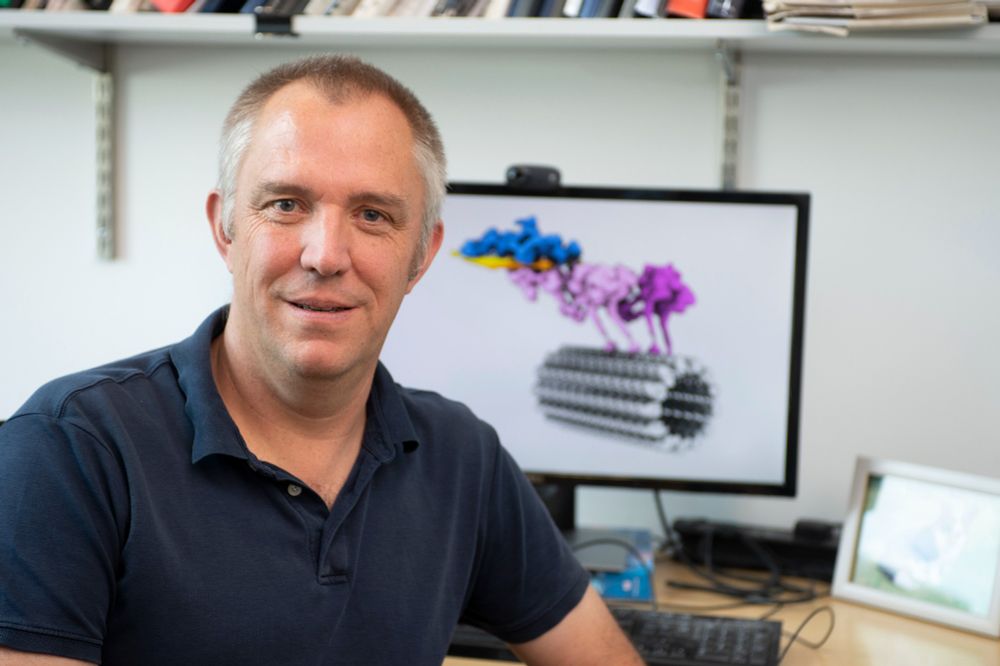
Exciting 3-year postdoc opportunity with @carter-lab.bsky.social within a programme aimed at identifying the links between microtubule motors and axonal cargos.
Read more about the role here:
www.nature.com/naturecareer...
Apply by 30 DEC
#ScienceJobs #CambridgeJobs #PostdocJobs #GenomeEngineering
12.12.2024 15:19 — 👍 48 🔁 39 💬 0 📌 2
Assistant Professor at UT Austin
www.bayersantoslab.com
Investigator scientist @MRC-LMB,
GPCR structures and cryoEM method development
Also 🎸🎹🎻🏃♀️🧗♀️🚵♀️📷
We study gut bacteria and the immune response to infection with a focus on the danger signal extracellular ATP. We particularly like Shigella and E. coli. Located at Queen's University Belfast, UK and Umeå University, Sweden.
PhD student in Enninga lab, Institut Pasteur. Shigella, microscopy and cytoskeleton 🦠🔬🧫
Finishing PhD candidate (Blaskovich Lab, IMB @ UQ)
Synthetic chemistry & microbiology (let's tackle biofilms!)
Can be found dancing, surfing, & cycling 💃🏼🍊🌻🧪🌊🧬⌬
Working and living on unceded lands
Cell biologist interested in autophagy and TORC1: The University of OSAKA
Post-doc at UCL/London Centre for Nanotechnology (https://www.hoogenboom-lab.com/).
Biophysicist 🧪 using atomic force microscopy 🔬 to map outer membrane biogenesis at the single-protein level in living bacteria 🦠
Distinguished Professor University of California Davis
Member, NAS, AAM, Leopoldina, AAAS
Views are my dog's
Physician Scientist interested in all things mycobacterial: pathogen, model system, and cancer therapy. Immunology program/ID MSK. Opinions are mine and do not represent those of my employer, MSK.
https://scholar.google.com/citations?hl=en&user=xriihOcAA
Microbiologist, Assistant Professor at Western Michigan University
koestlerlab.com
Decoding how the gut thinks 🦠🪱🧠💪
Neuroscientist with interests in
#EnergyMetabolism #EntericNeurons #Fats
@crick.ac.uk @institutducerveau.bsky.social
Prof @cambridgebiosci.bsky.social Genomic epidemiologist connecting pathogen evolution with public health outcomes. #Shigella and #AMR enthusiast. Views own. http://gen.cam.ac.uk/baker-group also www.pdu.gen.cam.ac.uk also @pducambridge.bsky.social
PhD student @MPI Science of Light
Chair 5th Med Dept UMM, Heidelberg University
Kidney Transplantation and Cell Death Biology
🔬 Assistant Prof, Pathology @Duke | Director, Clin Micro Lab
🧫 Former Clin Micro Fellow @Memorial Sloan Kettering
👩🏻🔬 Former Postdoc @broadinstitute.org
🎓 PhD @The Rockefeller University
Focus: Diagnostics, AMR, Structural Biology
Industry Scientist | Sequencing and Cells
🦠 Postdoc @jcvi.org
🧠 PhD @utah.edu
Lecturer in Microbiology | He/Him | Medical Microbiology | Antimicrobial Resistance (AMR) | Genomic Epidemiology | Sexually Transmissible Infections | Bioinformatics | Public Health | Views are my own | Following ≠ endorsing
PhD student @ MRC-LMB
Studying Ub and Ubls in the context of immunity
Assistant prof @ UofT, associated scientist @ Helmholtz Institute for RNA-based Infection Research. Pathogen systems biology / informatics / functional genomics. Coastal New Hampshirite. Drink Moxie.

